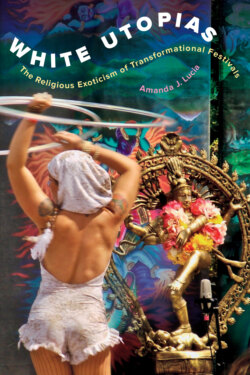White Utopias

Реклама. ООО «ЛитРес», ИНН: 7719571260.
Оглавление
Amanda J. Lucia. White Utopias
White Utopias. The Religious Exoticism of Transformational Festivals
Contents
Illustrations
Acknowledgments
Author Note
NOTE ON LANGUAGE
Introduction
THE AVAILABLE EXOTIC / THE USABLE PRIMITIVE: PLAYING INDIAN
SPIRITUAL, BUT NOT RELIGIOUS
WHITENESS AND WHITE POSSESSIVISM
THE FIELD(S) Transformational Festivals
Yoga
CHAPTER OUTLINE
1. Romanticizing the Premodern. The Confluence of Indic and Indigenous Spiritualities
THE SPIRITUAL BRICOLAGE OF TRANSFORMATIONAL FESTIVALS
CULTURAL APPROPRIATION AND ITS IMPACT
WHITE BHAKTAS AND THE POLITICS OF REPRESENTATION
GOING NATIVE: BECOMING A TRIBE
CONCLUSION
Interlude. Cultural Possession and Whiteness
2. Anxieties over Authenticity. American Yoga and the Problem of Whiteness
AUTHENTICITY AND AUTHORITY
WHY AUTHENTICITY? ESCHEWING THE VERY NOTION OF ESSENCES
LOCAL KNOWLEDGE
UNIVERSAL KNOWLEDGE
ON TRANSLATION, DOMESTIFICATION, AND APPROPRIATION
PROSTRATION VERSUS PLANK: THE “DOMESTICATING PROCESS” OF TRANSLATION
ARE THE TRANSMITTERS OF AMERICAN YOGA TRANSLATORS OR AUTHORS?
CONCLUSION
Interlude “White People Are on the Journey of Evolution”
3. Deconstructing the Self. At the Limits of Asceticism
THE PRODUCTIVE SPACES OF FESTIVAL
THE ASCETIC FESTIVAL: AN OXYMORON OF SORTS
TRANSFORMATIONAL FESTIVALS: THE VARIETIES OF ASCETICAL EXPERIENCE
GEOGRAPHICAL DISLOCATION, A FIRST STEP TOWARD ASCETICAL PRACTICE
DECONSTRUCTING THE OLD SELF TO CONSTRUCT THE NEW
EMOTIONAL DECONSTRUCTION
BODILY DISCIPLINE
DIETARY DISCIPLINES
CONCLUSION
Interlude. Sculpting Bodies and Minds
4. Wonder, Awe, and Peak Experiences. Approaching Mystical Territories
MYSTICISM IN MODERNITY
NATURE
ART
PSYCHEDELIC EXPERIENCE
DEVOTIONAL MUSIC
CONNECTION WITH OTHERS
CONCLUSION
Interlude. Producing Wonder / Branding Freedom
5. The Cathartic Freedom of Transformational Festivals. Neoliberal Escapes and Entrapments
FREEDOM FROM THE ENCLOSURES OF MODERNITY
FREEDOM FROM JUDGMENT
FREEDOM FROM RESPONSIBILITIES
FREEDOM FROM ISOLATION
YOGIC FREEDOM, SPIRITUALITY, AND NEOLIBERALISM
BUILDING THE COMMONS THROUGH COMMUNITAS
CONCLUSION
Conclusion
APPENDIX ONE @Instagram Data for Public Figures Cited
APPENDIX TWO. Methodology
Notes. INTRODUCTION
1. ROMANTICIZING THE PREMODERN
INTERLUDE: CULTURAL POSSESSION AND WHITENESS
2. ANXIETIES OVER AUTHENTICITY
INTERLUDE: “WHITE PEOPLE ARE ON THE JOURNEY OF EVOLUTION”
3. DECONSTRUCTING THE SELF
INTERLUDE: SCULPTING BODIES AND MINDS
4. WONDER, AWE, AND PEAK EXPERIENCES
INTERLUDE: PRODUCING WONDER / BRANDING FREEDOM
5. THE CATHARTIC FREEDOM OF TRANSFORMATIONAL FESTIVALS
CONCLUSION
APPENDIX 2: METHODOLOGY
References
Index
Отрывок из книги
The publisher and the University of California Press Foundation gratefully acknowledge the generous support of the Ahmanson Foundation Endowment Fund in Humanities.
UNIVERSITY OF CALIFORNIA PRESS
.....
National statistics reveal that the United States is still a majority-white nation, with 76.5 percent of the population identifying as white and 60.4 percent identifying as white (non-Hispanic/non-Latino).48 Thus, one could argue that the ethnic composition of Burning Man and LIB closely mirrors national averages. In contrast, the more yogic festivals (Wanderlust, Bhakti and Shakti Fests) exceed national statistics of white majority by 15 to 20 percent. These figures become more incongruous if one considers the population percentages of non-Hispanic whites; when compared to those statistics, these festivals range from 20 to 45 percent whiter than the national average. The figures become even more stark if one attends to geography a bit more closely. Burning Man and LIB are as white as Oregon (77 percent white [non-Hispanic]), and the more yogic festivals are whiter than Maine (93.7 percent white [non-Hispanic]).49 This is despite the fact that many of these transformational festivals either take place in or draw on populations from California, a state where non-Hispanic whites comprise only 38.8 percent of the total population.50 For example, nearly 500,000 Indian Americans live in California, 120,000 of them in Los Angeles, but a mere handful of Indian Americans attend Bhakti and Shakti Fests, held just 128 miles from downtown Los Angeles.
When I started to study these festivals, I was most interested to uncover the nuances in the translation processes of globalized yoga and, particularly, its relation to Hinduism. Upon entering the field, I was struck by the significant presence of Native American traditions, and as a result, I began to further explore the soteriological composition of the category of spirituality in these SBNR populations. Importantly, SBNR populations are less white than the transformational festival and yogic communities that this study engages. SBNR populations are still predominantly white (67 percent), but there are growing numbers of African Americans and Latinx Americans who identify as SBNR.51 Throughout this book, I use the term SBNR as a convenient shorthand, noting throughout that while transformational festival participants largely identify as SBNR, people of color who also identify as such are not represented in these fields.
.....